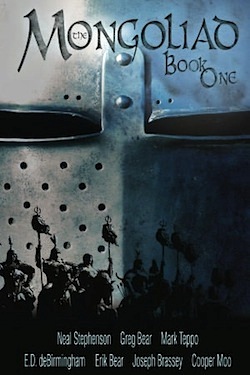Back in 2007, I wrote a 12-part online hypertext serial. Initially, it was a tiny experiment in looking at the accidental narratives that came out of cross-linking between commonly used words. It turned into a rabbit hole of oneiric proportions. As I was writing it in near real-time, it became a trial by fire. I survived, and I made myself a promise that I would never do anything like that again.
Two years later, The Mongoliad launched. [Read an excerpt from it right now on Tor.com!] This time, it was an online serial with SIX other writers. It ran 58 chapters, and took us just a little over a 16 months to finish. I was point man—canon master, cat herder, guy who writes stuff when everyone else had the flu or books due or other maladies that kept them from the keyboard—all while trying to hit that weekly deadline (if you do the math, you can see we didn’t quite hit it).
I’m a bit slow to see the obvious point the Universe was trying to make, but eventually, I figured it out: never dare the Universe to raise the stakes.
Fortunately, there were a couple other useful lessons I picked up along the way.
I like to joke that ninety percent of my job is herding cats, and there’s a little cry for help in that joke. Because really? Keeping a room full of writers on task is EXACTLY like herding cats; it’s only worse in the sense that a great deal of the magic of a writers’ room only happens when your cats have gone and gotten very distracted. Writers, as solitary thinkers, tend to spin stories out of nothing but moonbeams and cobwebs and whatever the latest Internet meme is that is keeping them from doing pay work. You put a bunch of them in a room, and the story generation becomes exponential. In many ways, the easiest part of managing The Mongoliad was letting the ideas in the room run unhindered.
Though, that can bite you in the ass. Case in point: the entire “second season” plotline where Onghwe Khan returns to Karakorum with General Subutai and they take the Mongolian Spirit Banner and head off to conquer China with our intrepid band of Western fighters (and one plucky, yet dissolute, Nipponese ronin in tow) in hot pursuit. Yeah, that entire plot died one day when Someone Who Shall Remained Unnamed dropped a Big Idea on the table and sat back with a wicked gleam in his eye. Oh, he knew damn well what he was doing, and it took the team about fifteen minutes to latch onto the idea like a bunch of Mongolian Death Worms.
Because the ideas came quickly, we had to be flexible and adaptable. We were writing serialized pulp, attempting to build a long-form narrative while still hitting those weekly cliffhangers that kept our audience coming back for more. We learned that having four major narrative branches was an exercise in cruelty because it would be as long as a month before we got back to any given branch.
We started with three branches, by the way. Four made the monthly schedule easier. One of the writers on the fourth branch asked me how he should approach his branch. I pointed at Neal and Greg, who were not working on that branch at that time, and said, “Make our audience skip their branch because yours is that much more awesome.” Three months later, Neal and Greg were dabbling in that branch because Joe had piled up a mountain of awesome.
In the beginning, we planned to be very structured—two writers on each of the four branches—and then someone pointed out that we only had seven writers. I did some hand-waving, pretending that the math really did work, but I was playing a shell game behind the scenes, shuffling writers back and forth between the branches. It turned out to be the right choice as we went along, because it became more and more difficult to tell who wrote what after six months. We were all poking at each other’s story lines, working to our strengths (some were better at hitting plot points; others liked to come in later and do what we called the ‘T & A’ pass—the tone and atmosphere edit), and not getting complacent with any one set of characters. For some of us it was Fiction Boot Camp: write or die.
We had a goal. We knew the broad strokes of the story we wanted to tell. We knew what we didn’t want to do, and we knew the path we were going to take was going to change along the way. We knew we were going to make mistakes—both in our continuity and in our research—but we had a vibrant fan community ready and waiting to point out our gaffes (the discussion of Herrmeister versus Heermeister is one nudge away from becoming a burning topic again). We were conducting an experiment. We gave ourselves permission to crash and burn in a spectacular fashion because, well, people enjoy a good spectacle.
We tricked everyone, though. We wrote a damn good story instead, and we made it look like we knew what we were doing the whole time. We didn’t. We made a lot of things up along the way. Some of those things are on the page.
Have we learned our lesson? No. Because our next project is something we’re calling The Side Quests. It’s more than two dozen shorter pieces scattered across the Foreworld timeline that runs from 400 BC to 1914 CE. Our knights have a long and colorful history. The Mongoliad, really, is only the beginning.
See? Never—ever—dare the Universe to raise the stakes.
Mark Teppo is the CEO and Chief Creative Officer of Subutai Corporation. He’s in the franchise-making business, and during the writing of The Mongoliad, he was Creative Lead. He is responsible for killing your favorite character.










